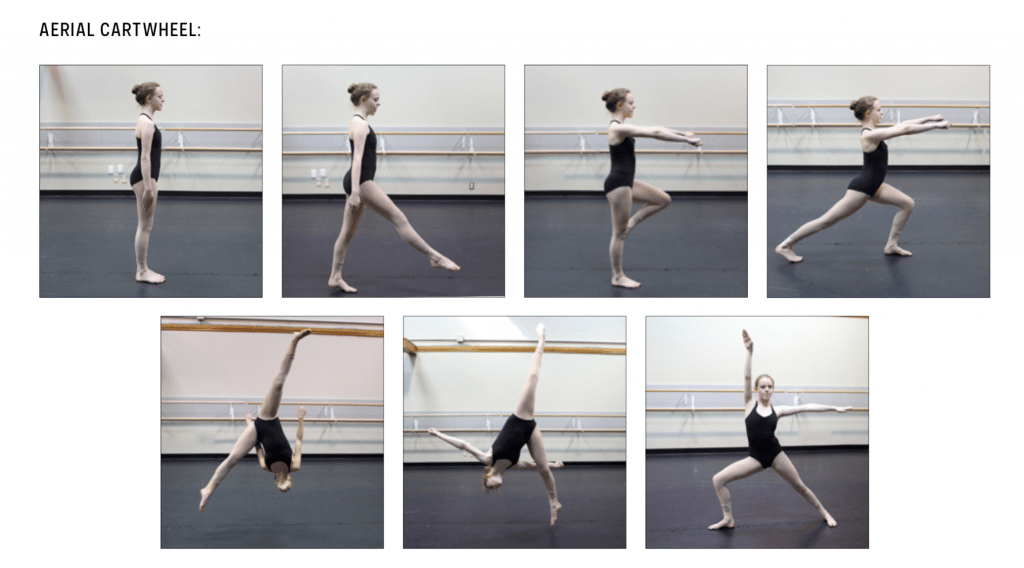Ask any student: what is the number one trick you want to learn in Acro class? The answer is always the same – an Aerial! The Aerial is one of the most challenging Acro tricks to learn, despite the fact that it is actually NOT one of the most difficult tricks to execute once mastered. Most students require at least one to two years to learn it but, once achieved, it feels very simple and is one of the more versatile tricks to use in choreography.
In accordance with the ADTA method, a Side Aerial is best taught from a step, retiré lunge preparation, with the chest up on the take-off, and a strong drive back with the arms (arms are reaching straight up and vertical in the upside-down position); it ends in a strong square lunge of the first leg (the absorbing leg), with a stretched and strong landing of the second leg (the braking leg), with the upper body finished open to the audience and the arms in Acro 4th Position. (More on this ending position later)!
ADTA Syllabus creator, Melissa Klassen, has analyzed Aerials for over 20 years; she has studied several different methodologies and approaches during her quest to find the best way to teach Aerials (and was personally taught several INCORRECT and INEFFICIENT ways in the process!).
After several different generations of students, and having tried EVERY imaginable method to teach and execute an Aerial, she invented the following 4-step approach to teaching/learning this highly sought-after trick.
- Step #1: Have your student perform a step, retiré, lunge out (finishing with the chest completely upright, and the arms reaching forward in horizontal). Have your students simultaneously jump up out of the lunge, and swing the arms back 180* HARD! Practice this drill across the floor for a minimum of two months.
- Step #2: Next, the student performs step #1 but then lands back in the lunge (on the front foot only), swings the arms all the way back, up and over the top, carrying through to a Cartwheel, finishing in an open lunge position, absorbing with the first leg and braking with the second leg. Practice this drill for a minimum of two months.
- Step #3: Then, when your student understands the timing and flow of step #2, have them combine the whole movement WITHOUT landing back in the lunge before taking off into the Cartwheel: step retiré lunge, hold the lunge, jump up out of the lunge while simultaneously swinging the arms back and over the top, and land directly into a Handstand to Cartwheel out. Most of your students will be at this stage for approximately four to six months.
- Step #4: The only difference between step #3 and Step #4 is that there is no stop in the lunge. The student uses all of the same technique as in step #3, but carries it through to one fluid trick, landing with the hands on the floor and Cartwheeling out. The student keeps practicing this step until he/she is ready to leave the arms off of the floor for a true Side Aerial. Most students will spend another 6 to 12 months on this step before keeping arms off the floor.
If you take the one to two years necessary to perfect the technique in each step, your students will be able to perform stunning, high Aerials that “pop” off of the ground beautifully and SAFELY. This four-step method also greatly reduces the amount of spotting required for each student, and students that take the time to learn this proper Aerial technique will have their Aerials for LIFE.
As a bonus, this four-step method utilizes the same technique that is used to achieve a Front Aerial, making the transition from mastering a Side Aerial to learning a Front Aerial seamless – two tricks for the price of one!
Why You Should NOT Teach Aerials from a Running Preparation:
Students that learn Aerials from a running preparation come to depend on momentum to take off, instead of learning to push from the hip joint. When a student learns how to push out of his or her hip joint, he/she is able to “pop” off the floor easily, enabling him or her to dance into and out of the Aerial flawlessly, without the use of an obvious preparation.
Why Aerials Should Finish in a Strong Lunge:
At the ADTA, we emphasize the need for aerials to finish in strong square lunge of the first leg (the absorbing leg), with a stretched and strong landing of the second leg (the braking leg), with the upper body finished open to the audience and the arms in Acro 4th position. This is to get your students used to a one-footed landing. The second leg is merely a brake, and there should be a brief pause between the landing of the first and second foot on the floor. When students are used to landing on one foot (instead of immediately shifting weight onto the second foot), their second foot is still “free” and available for creative transitions, such as a turn, leg extension, or even another aerial!
Check out this excerpt from the ADTA Intermediate Syllabus book – Aerial Cartwheel from a step:



